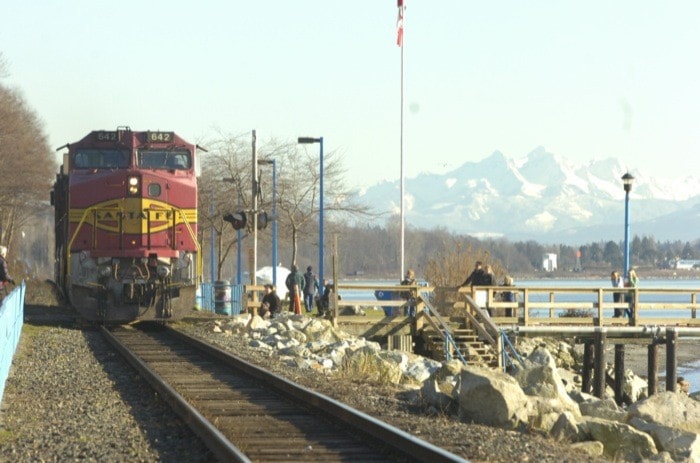A technical study on whether it’s feasible to move the Burlington Northern Santa Fe (BNSF) Railway train tracks inland from the White Rock and Surrey waterfront will cost about $700,000.
And it’s a move that will largely benefit White Rock and do little for Surrey residents, according to Surrey Mayor Linda Hepner.
“The real winners would be the City of White Rock,” Hepner said Wednesday.
“They don’t have to look at ‘what are the implications of that move and what does it mean for others?’”
That said, she notes relocation is worth a closer look.
“It’s a big decision and worthy of analysis,” said Hepner, noting placing some of the track underground must be considered. “We are probably not the only city in the country looking at… vulnerabilities and what the options are.”
Surrey council voted Tuesday evening to have staff examine the possibility of cost sharing with the province and White Rock before finding a firm to conduct the study.
White Rock Mayor Wayne Baldwin – who along with his council named rail relocation as one of the city’s strategic priorities last fall – said in September that his city was waiting for Surrey to commit to a joint application to the Canadian Transportation Authority on the matter. Noting that “three-quarters of the rail frontage is in Surrey,” Baldwin said it makes more sense that the cities band together on the issue.
“If there’s going to be an accident, it’s going to happen in Surrey, so they have a vested interest in this,” he said, a sentiment he reiterated at his Oct. 7 state-of-the-city address to the South Surrey & White Rock Chamber of Commerce.
Earlier this month, Hepner told Black Press she agreed the two cities “need to have a united front on this issue” and that there are some “Surrey-specific issues” that need to be examined first.
In September 2014 – in one of the first public speeches of her Surrey First mayoral campaign – Hepner announced in Crescent Beach that she was committed to relocating the BNSF line, pledging a focus on the issue and naming safety as her biggest concern with the trains. She cited the impact to access and egress from Crescent Beach whenever a train breaks down in the area, and questioned how many more heavy, long trains the bluffs can take.
“These trains are now completely isolating an entire community,” Hepner said, promising that, if elected mayor, she would immediately engage BNSF in discussions to have the tracks moved to a more direct, faster and safer inland route.
She also acknowledged then that she hadn’t always backed the call for relocation, noting in the past she was “not certain the frequency (of the trains) warranted it.”
Train activity along White Rock’s waterfront has increased over the past 16 years, leaving several residents in that city concerned about possible negative outcomes. The route sees trains run along the White Rock and Crescent Beach waterfronts.
Fears heightened after the Lac-Mégantic rail derailment disaster on July 2013. Forty-seven people in the Quebec town were killed in that petroleum explosion, which leveled roughly half of the downtown core of Lac-Mégantic.
A jogger was also killed on the tracks in White Rock that same month.
A corporate report to Surrey council outlines some of the other concerns being raised by residents near the track.
“Transportation of simple construction materials and mail has transitioned to include coal, and other materials such as chlorine and liquefied natural gas,” the report to council states.
It outlines concerns of locals, including noise disruption, public safety, bluff erosion, dangerous goods, incident management and environmental concerns.
The report indicates the technical study and preparation work will cost at least $700,000.
The cost of moving the tracks is estimated at at least $350 million to $450 million, and far more if the track needed to be realigned to a spot underground.
And that’s the only way Hepner would consider moving it.
“I am not prepared to talk about moving the track from one arena, and then creating a problem in another arena,” Hepner said Wednesday. “All of that work I want better-defined before we look at that.”
It will take three to five years to complete all the preparation work, including studies and consultation with the federal transportation agency.
– with files from Melissa Smalley,
Alex Browne & Tracy Holmes
